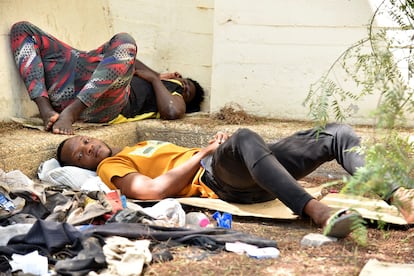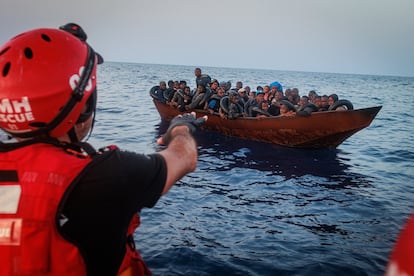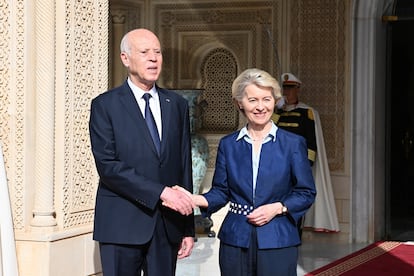Tunisia overtakes Libya as the top migrant launch point for Europe
A record 20,000 people departed from the North African country in July alone

Heartbreaking shipwrecks of migrant-filled boats departing from the Tunisian coast for Europe have surged in recent months. The latest tragedy claimed the lives of 41 people near Italy’s Lampedusa Island in early August. The alarming death rate reveals a trend that has been unfolding since the beginning of the year: Tunisia has supplanted Libya as the main starting point in the Mediterranean for migrants desperate to reach the shores of the European Union (EU).
According to data from the Italian Interior Ministry leaked to the Agenzia Nova news agency, at least 34,761 migrants arrived on the Italian coast from Tunisia in the first six months of 2023, more than the 27,859 people who departed from Libya. The number of migrants departing from Tunisia this year is almost five times higher compared to the same period last year, when it did not exceed 7,000. A record 20,000 people departed from the North African country in July alone.
“Recently, a huge number of boats have departed from Tunisia. Just this past weekend, around 2,000 people left the country,” said Òscar Camps, director of the Spanish non-profit Pro Activa Open Arms. Camps has recently spent several weeks aboard a ship rescuing migrants in the central Mediterranean. The migrants boats usually head for Lampedusa, an Italian island just 110 miles (180 kilometers) from the city of Sfax in Tunisia, and 186 miles (300 kilometers) from the Libyan capital of Tripoli.
Approximately 90,000 migrants have reached the Italian coasts in 2023, double the number from the previous year. Italy has become the top destination in the EU, drawing over 65% of all irregular migrant arrivals in Europe, according to the International Organization for Migration (IOM). Once again, the busiest route is across the western part of the Mediterranean Sea.
In Libya, specifically in the eastern half of the country, efforts to exert more control over outbound migration have intensified. Reuters reports that Libyan authorities there led by General Khalifa Hafter operate with significant autonomy from the central government in Tripoli, and have recently deported thousands of migrants from sub-Saharan Africa, Bangladesh, Pakistan and Egypt. Tunisia has yet to adopt such measures.

According to Italian government data confirmed by Romdhane Ben Amur, a migration researcher at the Tunisian Forum for Economic and Social Rights (FTDES), Italy provides information on migrant nationality rather than their departure countries. “This [data] indicates that Tunisia has become the main departure point for Europe, surpassing Libya,” he said. The most common migrant nationalities declared to Italian authorities this year are Guinea (12%), Ivory Coast (11%), Egypt (8%) and Tunisia (7%). Ben Amur says there are two reasons for the sudden increase in departures from Tunisia. “There has been a rise in migrants coming here by land through Algeria, due to the leniency of the Algerian police. And routes through the Canary Islands and the Balkans been closed off, so many migrants shifted to Tunisia.”
Tunisian president’s speech sparks racist attacks
Ben Amur also attributes the trend to a speech given by Tunisian President Kais Saied before the country’s National Security Council in February. “A lot of sub-Saharan migrants who were staying in Tunisia temporarily to work, save up, and pay for their trip to Europe actually decided to speed up their migration plans because of the racist attacks caused by Saied’s statements,” said Ben Amur. Saied lashed out about a “criminal plan” to change the “demographic composition of Tunisia” and replace its Arab and Muslim population with “hordes” of sub-Saharan migrants. In the days after his speech, Tunisian mobs lynched Black migrants with the complicity of security forces, while many others were fired from jobs and evicted from homes.
In early July, a new wave of racist attacks broke out in Sfax, the Tunisian city with the largest sub-Saharan migrant community. “The president’s visit provoked more attacks, and a young Tunisian was killed in one confrontation. The police then deported over 1,500 people to the borders with Libya and Algeria,” said Franck Yotedje, director of the Sfax-based Africa Intelligence non-governmental organization. At least 20 deportees died from lack of water, food and protection against the extreme heat.
The rise in deaths at sea is another consequence of state-sanctioned racism in Tunisia. Opportunistic smugglers capitalized on the surge of migrants by using unsafe boats. According to the IOM, 40% of the 2,387 people who lost their lives or went missing in the Mediterranean this year left from Tunisia (467 died in March and April alone). “Lately, there have been instances of very flimsy sheet metal boats departing from Sfax that take on water almost immediately,” said Òscar Camps of Pro Activa Open Arms.

Camps highlights a third factor that explains the mass migrations from the Tunisian coast: the deliberate utilization of migration as a means to “extort” the European Union. “The situation in Tunisia is scandalous. Radio conversations between Tunisian fishermen and the coast guard indicate clear collusion to aid the passage of these boats,” he said. Camps used a drone camera and easily detected a jetty on the coast where dozens of people were making these dangerously flimsy boats. “The Tunisian authorities can’t possibly miss this,” he said.
Camps’ claims align with a confidential analysis of the EU borders conducted by Frontex and obtained by EL PAÍS. The report indicates that Tunisian fishing boats frequently approach migrant boats stranded at sea and offer to tow them close to Lampedusa for money. If the migrants say no, the fishermen resort to intimidation tactics and churn up dangerous waves that imperil the unstable boats.
Renewed attention from the European Commission
The increase in migration from Tunisia has led to renewed attention from European and Italian authorities in the small North African country. On July 16, Ursula von der Leyen, President of the European Commission (EC) traveled to Tunisia with Italian Prime Minister Giorgia Meloni and Mark Rutte, Prime Minister of the Netherlands, to sign a “strategic partnership” agreement. The aim is to make it a role model for other countries in North Africa. The main focus of the pact is cooperation in controlling border flows; the EC will give Tunisia $115 million (€105 million) to enhance its capacities in this area. The EC will also offer Tunisia an additional $164 million (€150 million) in budgetary support and promises another $986 million (€900 million), pending the signing of a loan agreement with the International Monetary Fund (IMF).
According to Tunisian analysts, Saied showed great interest in signing the agreement and ending the country’s international isolation after its self-coup in 2021 and his own racist remarks in February. The country urgently needs international support due to its severe and ongoing financial crisis. As part of the agreement, Saied has proposed increased collaboration with the EU to expedite the repatriation process of irregular Tunisian migrants in Europe. “If you’ve noticed a growing number of boats on the Tunisian coast, it’s because Saied is still in talks with the EU,” said Camps. “The ranking of the countries sending these boats is changing accordingly. It used to be Türkiye, now it’s Tunisia, and soon it will be Algeria. It’s just how they’re managing the borders now.”
Sign up for our weekly newsletter to get more English-language news coverage from EL PAÍS USA Edition
Tu suscripción se está usando en otro dispositivo
¿Quieres añadir otro usuario a tu suscripción?
Si continúas leyendo en este dispositivo, no se podrá leer en el otro.
FlechaTu suscripción se está usando en otro dispositivo y solo puedes acceder a EL PAÍS desde un dispositivo a la vez.
Si quieres compartir tu cuenta, cambia tu suscripción a la modalidad Premium, así podrás añadir otro usuario. Cada uno accederá con su propia cuenta de email, lo que os permitirá personalizar vuestra experiencia en EL PAÍS.
¿Tienes una suscripción de empresa? Accede aquí para contratar más cuentas.
En el caso de no saber quién está usando tu cuenta, te recomendamos cambiar tu contraseña aquí.
Si decides continuar compartiendo tu cuenta, este mensaje se mostrará en tu dispositivo y en el de la otra persona que está usando tu cuenta de forma indefinida, afectando a tu experiencia de lectura. Puedes consultar aquí los términos y condiciones de la suscripción digital.
More information

From Lampedusa to Calabria: 10 years of immigration policy failures
Archived In
Últimas noticias
Imelda Castro, the woman who wants to rule the cartel battleground of Sinaloa
The new victims of the Republican war on Obamacare: Millions hit by soaring health insurance premiums
A country divided on migrant rights: Some US states expand protections while others restrict them
Venezuela authorizes the release of another 87 political prisoners
Most viewed
- David King, chemist: ‘There are scientists studying how to cool the planet; nobody should stop these experiments from happening’
- Reinhard Genzel, Nobel laureate in physics: ‘One-minute videos will never give you the truth’
- Oona Chaplin: ‘I told James Cameron that I was living in a treehouse and starting a permaculture project with a friend’
- Sinaloa Cartel war is taking its toll on Los Chapitos
- The Interoceanic Train, the Mexican alternative to the Panama Canal








































